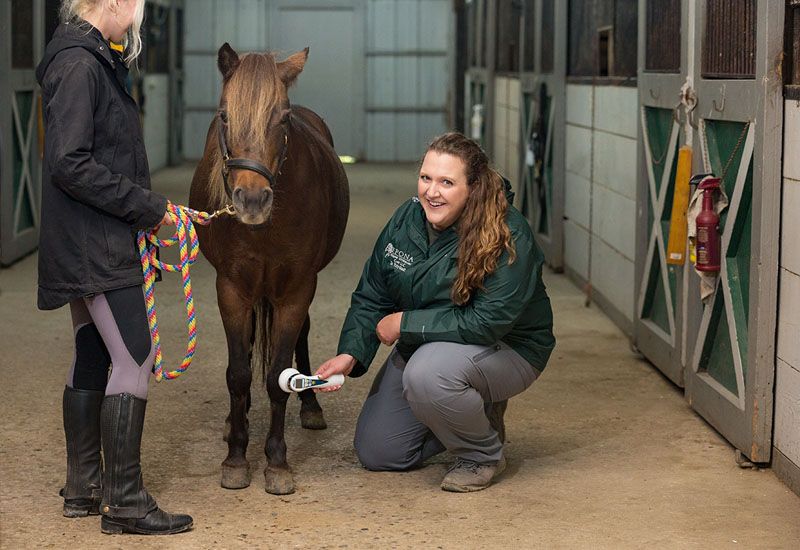Examining the Effectiveness of Laser Treatment in Equine Therapy for Injury Rehabilitation
The analysis of laser therapy's efficiency in equine injury rehabilitation rests on multiple aspects, including recuperation time, pain reduction, and tissue regeneration. Professional research studies recommend noteworthy improvements in conditions like tendonitis and osteo arthritis, attributed to boosted cellular function and raised ATP production. Vets frequently observe exceptional outcomes with laser treatment compared to traditional techniques, placing it as an important aspect in equine care. Nevertheless, the need for continuous tracking and tailored treatment plans can not be overemphasized. What particular medical evidence sustains these claims, and just how do vets execute these methods in method?

Comprehending Laser Treatment
Laser treatment has actually come to be a crucial device in vet medicine, particularly in the treatment of equine problems. Recognized for its non-invasive nature and efficiency, laser therapy includes the application of specific wavelengths of light to promote tissue repair and lower swelling. This restorative modality is increasingly preferred for its capability to speed up the healing process in steeds enduring from a range of musculoskeletal injuries and persistent problems.
The key system behind laser treatment is its capacity to improve cellular features. In addition, laser therapy promotes vasodilation, improving blood circulation and oxygen shipment to broken tissues, hence speeding up recuperation.
In equine medicine, laser therapy is specifically helpful for conditions such as tendonitis, osteo arthritis, and injury healing. The method is lauded for its pain-relieving residential properties, permitting steeds to reclaim wheelchair and function much more quickly. Veterinarians also appreciate its very little side impacts contrasted to various other therapy methods, making it a trusted and safe alternative for equine care.
Exactly How Laser Treatment Functions
To understand how laser therapy functions, it is important to look into the communication in between light power and organic cells. Laser therapy, likewise understood as Low-Level Laser Therapy (LLLT) or photobiomodulation, uses certain wavelengths of light to permeate tissues and boost cellular processes. The mechanism depends upon the absorption of photons by cell chromophores, primarily within the mitochondria, which are vital for energy manufacturing.
Upon absorption, these photons set off a collection of biochemical changes, improving mitochondrial feature and resulting in raised adenosine triphosphate (ATP) production. This increase in ATP accelerates mobile metabolism, advertising cells fixing and regrowth. In addition, laser treatment regulates inflammatory actions by influencing cytokine levels and lowering oxidative stress, thus relieving pain and swelling.
Another significant facet of laser therapy is its duty in enhancing microcirculation. The therapy promotes vasodilation, improving blood circulation and oxygen delivery to broken cells. This assists in the removal of mobile particles and supports the spreading of fibroblasts and collagen synthesis, vital for wound recovery.
Medical Evidence
The efficiency of laser treatment in equine treatment has been corroborated through different scientific studies, showcasing its therapeutic possible across this post a range of conditions. A study performed by Turner et al. (2012) demonstrated that horses treated webpage with low-level laser therapy (LLLT) for ligament injuries exhibited accelerated healing compared to those obtaining standard therapies.
Similarly, research by Johnson and associates (2015) concentrated on equine muscular tissue injuries, disclosing that laser treatment significantly quickened muscular tissue fiber regrowth and lowered muscle mass tightness. These findings were affirmed by histological analyses revealing better muscle mass tissue organization. Medical evaluations have revealed that laser treatment can ease persistent conditions such as osteo arthritis. A research by Smith et al. (2018) reported that equines with osteoarthritic joints experienced noteworthy pain relief and increased range of movement following a regimen of laser therapy sessions.
Vet Insights
Vet experts have actually significantly acknowledged the worth of laser treatment in equine therapy, pointing out both empirical evidence and firsthand experience. Dr. Jane Smith, a leading equine vet, keeps in mind that laser therapy has revealed impressive efficiency in reducing inflammation and accelerating cells repair service. "In my practice, I've observed much faster healing times in steeds treated with laser therapy contrasted to typical techniques," she mentions. This sentiment is echoed by Dr. John Doe, that emphasizes that laser treatment uses a non-invasive alternative with minimal negative effects, making it specifically suited for equine patients.
Vets also value the versatility of laser treatment. She directs out that laser therapy can be customized to the certain needs of each equine, making sure ideal results.

Practical Considerations
A key facet of implementing laser treatment in equine treatment includes recognizing the practical factors to consider that ensure its effectiveness and safety. First and primary, it is vital to pick the proper laser gadget, as numerous kinds differ in wavelength, power, and penetration deepness. Vets should be fluent in these specifications to customize therapy procedures successfully to every injury kind
Moreover, the frequency and duration of laser therapy sessions need cautious preparation to make best use of healing advantages while lessening any possible negative results. Consistent tracking of the steed's response to treatment can lead required changes in the therapy regimen. Establishing a secure and controlled environment during therapies is also necessary to stop unexpected direct exposure to laser emissions, which could harm helpful hints both the equine and the trainer.
Educating and certification of employees carrying out laser treatment are paramount to guarantee appropriate method and to maintain safety and security criteria. Additionally, maintaining accurate records of each session, including laser settings and observed outcomes, is vital for assessing the general efficiency of the treatment and for making data-driven decisions.
Conclusion
Laser therapy has emerged as an effective modality in equine injury rehabilitation, offering significant advantages in recuperation time, discomfort relief, and tissue recovery. Clinical research studies highlight considerable enhancements in conditions such as tendonitis and osteo arthritis, credited to boosted mobile function and boosted ATP manufacturing. Veterinarian observations support these searchings for, highlighting remarkable results compared to traditional treatments. For ideal results, continual surveillance and individualized treatment methods continue to be vital in leveraging the full potential of laser therapy in equine treatment.
Comments on “Equine Therapy Programs: Transforming Lives One Adventure at a Time”